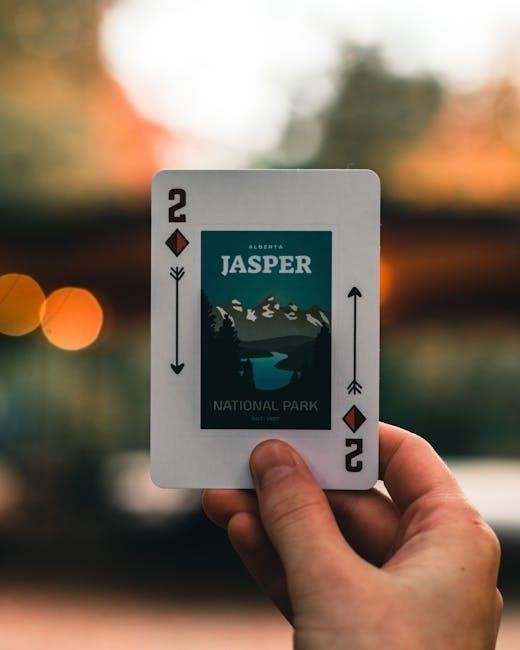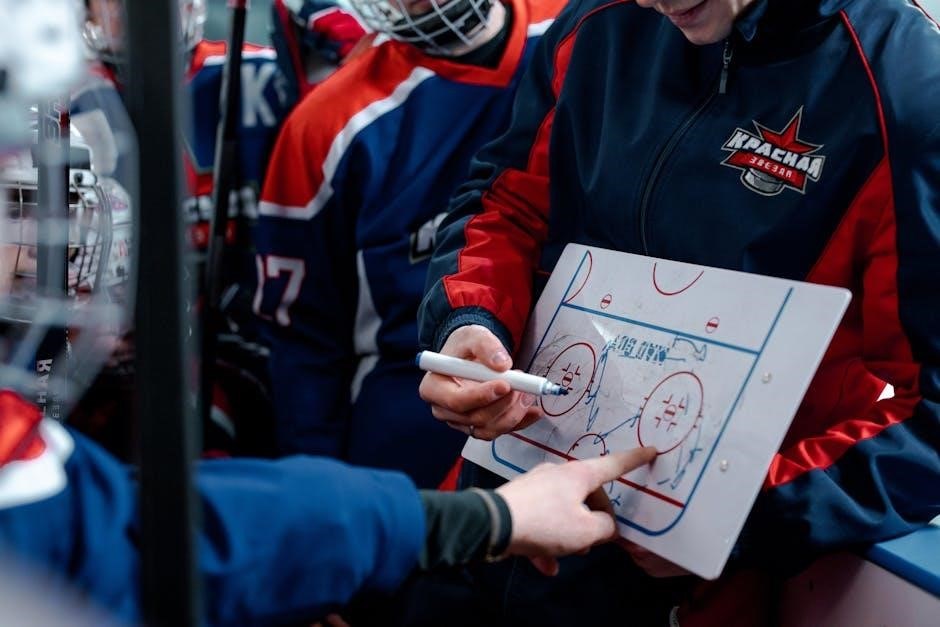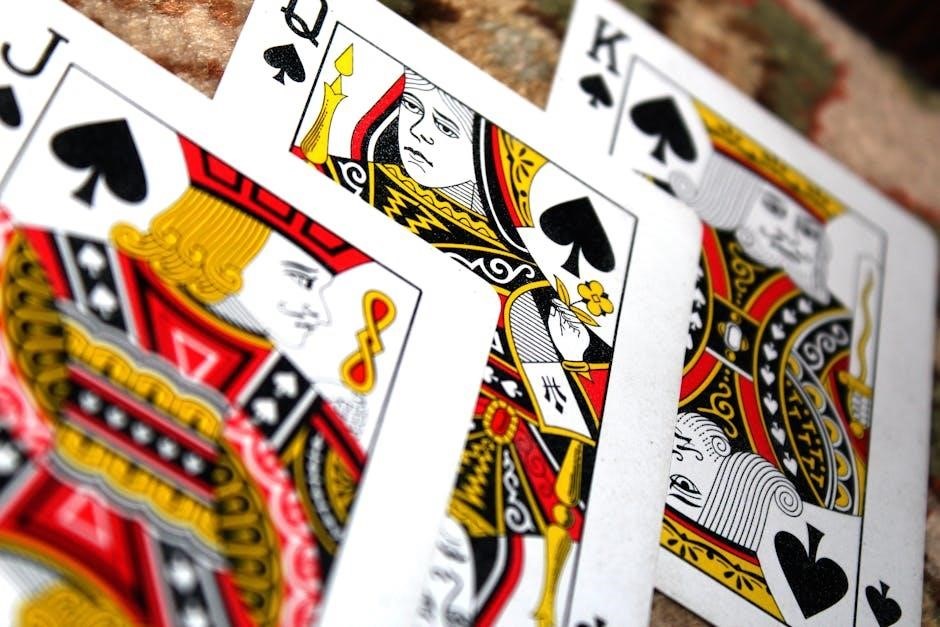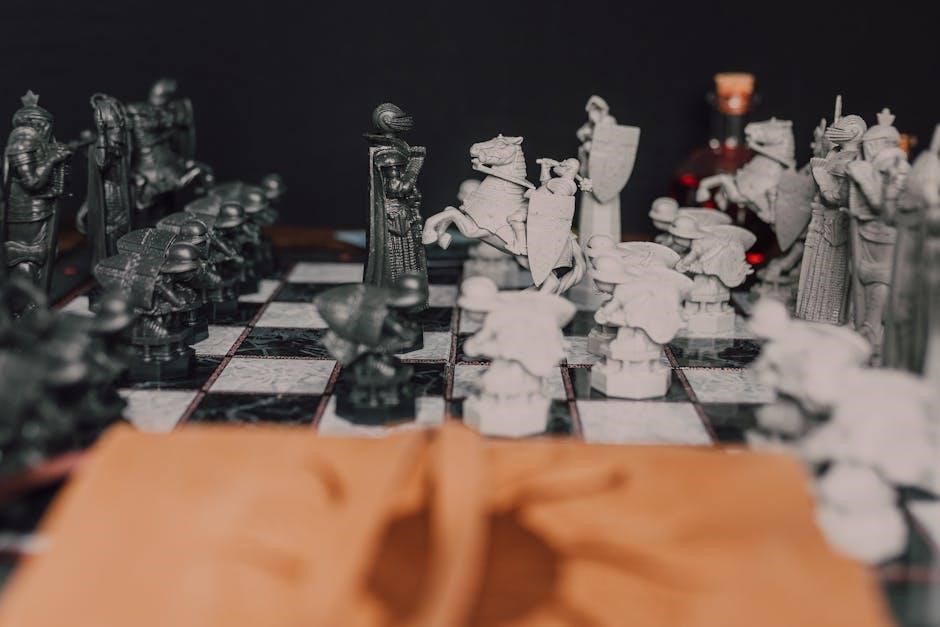Pit is a dynamic party card game for 3-8 players, where participants trade commodities like Flax, Corn, and Wheat. The goal is to corner the market by collecting matching cards, using the silver bell to end trading rounds. It’s a fast-paced, engaging game suitable for all ages, offering both basic and advanced modes for varying skill levels.
Overview of the Game
Pit is a lively and engaging party card game designed for 3 to 8 players, making it ideal for large gatherings or family fun. The game revolves around trading cards representing commodities like Flax, Corn, Barley, Hay, Rye, Wheat, and Oats. Players aim to corner the market by collecting matching sets of these commodities. The game is known for its fast-paced and dynamic nature, with players shouting out trades and using strategy to outmaneuver opponents. A unique feature is the silver bell, which signals the end of trading rounds and adds excitement to the gameplay. Pit is easy to learn but offers depth for strategic players, making it accessible to all ages while keeping experienced players engaged. The game also includes special cards, such as the Bull and Bear, which introduce penalties and wild card mechanics, adding layers of complexity and fun. With its simple rules and interactive design, Pit is a classic choice for casual and competitive card game enthusiasts alike.
Objective of the Game
The primary objective of Pit is to corner the market on specific commodities, such as Flax, Corn, Barley, Hay, Rye, Wheat, and Oats, by collecting a complete set of matching cards. Players aim to be the first to gather a full set of nine identical commodity cards, which allows them to “corner the market” and win the game. The game encourages strategic trading, as players must negotiate and exchange cards with others to achieve their goal. The silver bell plays a crucial role, as ringing it signals the end of a trading round, and the player who has successfully cornered the market gets to ring it. Special cards, such as the Bull and Bear, introduce additional challenges and penalties, adding depth to the gameplay. The combination of strategy, negotiation, and a bit of luck makes Pit an exciting and competitive experience for all players involved.
Number of Players
Pit is designed for 3 to 8 players, making it an ideal game for small to medium-sized groups. The game is most enjoyable with the maximum number of players, as it increases the excitement and competition. Each player starts with an equal number of cards, and the goal is to be the first to corner the market on a commodity. With more players, the trading dynamics become more complex and unpredictable, adding to the fun. While the game can technically accommodate up to 8 players, it can also be played with as few as 3, though the experience is less dynamic. The number of players directly impacts the pace and strategy of the game, with larger groups fostering more opportunities for trades and alliances. This flexibility makes Pit a versatile option for various social gatherings and events. The game’s design ensures that everyone remains engaged and active throughout the gameplay.
Equipment Needed
To play Pit, you’ll need a few essential items to get started. The game requires a custom 74-card deck, which includes 64 commodity cards, 9 Bull cards, 9 Bear cards, and 2 instruction cards. These cards are specifically designed for the game and feature various commodities like Flax, Corn, and Wheat. Additionally, a silver bell is a crucial component, as it is used to signal the end of trading rounds. The bell adds a unique and lively element to the gameplay. Instructions or rule cards are also provided to guide players through setup and gameplay. While the game doesn’t require a physical board, having a flat surface for dealing and organizing cards is recommended. Ensure all components are present before starting to avoid delays. The custom deck and silver bell are what make Pit distinct from other card games, so they are essential for an authentic experience.

Setup and Preparation
Begin by gathering all necessary components, including the 74-card deck and the silver bell. Ensure the playing area is clear and accessible for all players. The dealer should be chosen, and the cards must be shuffled thoroughly before dealing. Place the silver bell prominently to signal trading rounds. Verify that all players understand the rules and objectives. Proper organization and preparation ensure smooth gameplay and an enjoyable experience for everyone involved.
Choosing the Dealer
Selecting a dealer is a crucial initial step in Pit. One player is designated as the dealer, often chosen randomly or by mutual agreement. The dealer’s primary responsibilities include shuffling the deck, distributing the cards evenly among players, and managing the silver bell. It is essential for the dealer to perform these tasks efficiently to ensure a fair and smooth start to the game. The dealer should shuffle the cards thoroughly to prevent any player from gaining an unfair advantage. After shuffling, the dealer deals the appropriate number of cards to each player, ensuring each hand is complete. Once all cards are distributed, the dealer places the silver bell in the center of the playing area, signaling the start of the game. This process sets the stage for an engaging and competitive experience for all participants. The dealer’s role is vital in maintaining the integrity and organization of the game.
Shuffling the Cards
Shuffling the cards is a critical step in preparing for the Pit card game. After the dealer has been chosen, they are responsible for shuffling the deck thoroughly. This ensures a random distribution of cards and prevents any player from gaining an unfair advantage. The dealer should shuffle the cards multiple times, using a method of their choice, such as the riffle shuffle or overhand shuffle. It is important to mix the cards well to avoid any predictable patterns or groupings. Once the deck is sufficiently shuffled, the dealer proceeds to deal the cards evenly among the players. Proper shuffling is essential to maintain the fairness and unpredictability of the game, ensuring an exciting and competitive experience for all participants. This step sets the foundation for a balanced and engaging gameplay environment.
Dealing the Cards
After shuffling, the dealer distributes the cards evenly among the players. Each player receives an equal number of cards, ensuring fairness. The number of cards per player depends on the total number of participants, typically ranging from 3 to 8 players. For example, with 7 players, each player may receive 10 cards, while the remaining cards are set aside. The dealer must ensure that all players have the same number of cards to maintain balance. The silver bell is placed in the center of the playing area to signal the end of trading rounds. Dealing the cards is a straightforward process, but it must be done carefully to ensure no player gains an unfair advantage. Once all cards are dealt, the game is ready to begin, and players can start trading to achieve their goal of cornering the market.
Role of the Silver Bell
The Silver Bell plays a crucial role in managing the tempo and flow of the Pit card game. Strategically placed in the center, it serves as a signal to end trading rounds, ensuring the game progresses smoothly. Players are expected to ring the bell to indicate significant actions, such as completing a set or achieving a specific goal. This mechanism helps maintain a dynamic pace, preventing the game from lagging. The Silver Bell may also be associated with penalties or rewards, adding an extra layer of strategy. For instance, ringing it prematurely could result in a penalty, while timely use could grant advantages. Ultimately, the Silver Bell is essential for synchronizing player actions and keeping the game lively and engaging, fitting well within the fast-paced nature of Pit. It ensures that all players are aligned with the game’s progression, enhancing the overall experience.

Gameplay Basics
Pit is a fast-paced trading game where players aim to corner the market by collecting matching commodity cards. The Silver Bell signals key actions, while Bull and Bear cards add strategic twists to the gameplay.
The primary objective in Pit is to corner the market by collecting all nine cards of a single commodity, such as Wheat or Corn. Players achieve this by trading cards with others, strategically offering and accepting deals to complete their sets. The Silver Bell plays a crucial role, signaling the end of trading rounds and allowing players to lay down completed sets. Successfully cornering the market earns points, with the Bull card acting as a wild card to help complete sets, while the Bear card penalizes players. The goal is to be the first to rid yourself of all cards, avoiding penalties and outsmarting opponents to emerge victorious.

Trading Mechanism
In Pit, trading is the core mechanic that drives the game forward. Players initiate trades by calling out the number of cards they wish to trade, such as “two” or “three.” Only players offering or seeking the same number of cards can engage in a trade. Once a trade is agreed upon, the cards are exchanged, and players must immediately reveal any completed sets they have formed. The Silver Bell is rung to signal the end of trading for the round, and no further trades can be made after it has been rung. The Bull card can act as a wild card to complete a set, while the Bear card introduces penalties, disrupting opponents’ strategies. Strategic trading and timing are essential to corner the market and win the game.
Special Cards (Bull and Bear)
The Bull and Bear cards are unique and influential in Pit, adding strategic depth to the game. The Bull card is a wild card that can represent any commodity, helping players complete sets and corner the market. In contrast, the Bear card functions as a penalty card, disrupting opponents and hindering their progress. When a player collects the Bear, they must immediately discard one of their commodity cards, potentially delaying their ability to complete sets. These special cards can be used strategically to either advance your own goals or impede others. Understanding how to effectively utilize the Bull and Bear is crucial for success in Pit, as they can significantly impact the game’s outcome. Players must decide wisely when to play these cards to maximize their benefits and minimize penalties. They are essential components that add excitement and challenge to the game.
Going Out of the Game
Going out of the game in Pit occurs when a player successfully disposes of all their cards. The objective is to be the first to eliminate your hand by trading and matching commodities. When a player believes they have all nine cards of a single commodity, they can ring the silver bell to signal their exit. If the call is correct, they win the round and the game continues with the remaining players. However, if a player incorrectly claims to have all nine cards, they incur a penalty, such as drawing extra cards or being disqualified. The last player left with cards is often labeled the “loser” and may face additional penalties or teasing. The ability to go out of the game quickly is a key strategy in Pit, as it allows players to avoid penalties and secure victory. Timing your exit perfectly is crucial to succeed.

Advanced Strategies
Mastering the market, timing trades, and effectively using Bull and Bear cards are key. Anticipate opponents’ moves, avoid penalties, and strategically form sets to outmaneuver others for victory.
Understanding the Market
Understanding the market dynamics is crucial in Pit. Players must recognize the value of each commodity, as cards range from 40 (Flax) to 100 (Wheat). Observing which commodities are in higher demand or circulation helps strategize trades effectively. For instance, if Wheat is scarce, its value increases, making it a priority to collect. Conversely, over-saturated markets for Flax may require quick trades to avoid penalties. Recognizing these trends allows players to corner the market efficiently, ensuring they acquire the most valuable commodities first. This knowledge enhances trading decisions, enabling players to outmaneuver opponents and secure victory. Timing and observation are key to mastering market dynamics in Pit.
Timing Your Trades

Timing your trades is essential for success in Pit. Players must pay close attention to the rhythm of the game, as calling out trades at the right moment can make all the difference. When you hear another player calling out the number of cards you’re holding, act swiftly to negotiate a trade. The faster you respond, the better your chances of securing the cards you need. However, be cautious not to act too impulsively, as this can lead to unnecessary penalties or missed opportunities. The game’s pace is fast, so staying alert and ready to respond is crucial. Additionally, the silver bell signals the end of trading, so ensure you finalize your trades before it rings. Proper timing also involves observing other players’ strategies to anticipate their moves and stay ahead. Mastery of timing will help you outmaneuver opponents and achieve your goal of cornering the market.
Using the Bull and Bear Effectively
The Bull and Bear cards are powerful tools in Pit, capable of turning the tide of the game. The Bull can act as a wild card, allowing you to complete a set or trade strategically, while the Bear is a penalty card that disrupts opponents. To use them effectively, play the Bull when you need to fill a gap in your collection or force a trade. The Bear, on the other hand, should be played to penalize opponents, slowing their progress; Timing is crucial—use these cards when they will cause the most disruption or provide the greatest advantage. Be cautious, however, as improper use can backfire. Mastering the Bull and Bear cards adds depth to your strategy and enhances your ability to corner the market. They are not just random elements but key components of a winning approach in Pit.
Avoiding Penalties
Avoiding penalties is crucial to maintaining momentum in Pit. The Bear card, in particular, acts as a penalty card that can disrupt your progress. If you end up with the Bear, it’s essential to trade it away quickly to avoid being stuck with it at the end of the round. Similarly, holding onto unnecessary cards can lead to penalties, so always aim to trade strategically. Be cautious with the Bull card, as it can sometimes introduce penalties if not used wisely. To minimize penalties, focus on completing your sets efficiently and avoid holding onto cards that don’t contribute to your market control. Pay attention to the number of cards you’re trading and ensure they align with your goals. By staying alert and making calculated trades, you can reduce the risk of penalties and maintain your position as a competitive trader in the game.

Special Rules and Variations

Pit offers various gameplay options, including basic and advanced modes, team play, and shortened games. Custom rules can also be introduced for unique spins on the classic game.
- Basic vs. Advanced Modes: Simplified rules for beginners and complex strategies for experienced players.
- Team Play: Players can form teams to combine their resources and strategies.
- Shortened Games: Quick rounds for faster gameplay.
- Custom Rules: House variations to suit different player preferences.
Basic vs. Advanced Game Modes
The Pit card game offers two primary modes of play: basic and advanced, catering to different skill levels and preferences. In the basic game, the Bull and Bear cards are removed, simplifying the gameplay and focusing solely on trading commodities. This mode is ideal for newcomers, allowing them to grasp the core mechanics without additional complexities. The advanced game, however, includes the Bull and Bear cards, which introduce strategic depth. The Bull can act as a wild card or incur penalties, while the Bear always imposes penalties, adding layers of risk and reward. Players in advanced mode must carefully navigate these elements to corner the market effectively. The choice of mode depends on the players’ experience and desire for complexity, making Pit adaptable to various groups and preferences.
Team Play Options

Pit can be enjoyed in team play, adding a collaborative twist to the classic game. Teams are formed by dividing players into groups, with each group acting as a single player. This mode is ideal for larger gatherings, as it allows more participants to engage simultaneously. Teams must coordinate their trades and strategies to corner the market collectively. Communication is key, as team members can discuss which commodities to focus on and how to optimize their trades. The number of commodities in play may be adjusted based on the number of teams to ensure balanced gameplay. Team play introduces a new layer of strategy, as members must work together to avoid penalties and maximize their chances of winning. The silver bell still plays a central role, with teams ringing it to end trading rounds and claim their victories. This mode is perfect for fostering camaraderie and shared excitement among players.

Shortened Game Variations
For a quicker game, Pit can be adapted into shortened variations; One popular method is setting a lower winning threshold, such as 250 points, where the first player to reach this score wins. This reduces the overall gameplay duration while maintaining the excitement. Another option is limiting the number of rounds, allowing players to enjoy the game in a shorter time frame. Additionally, some players opt to remove certain commodities or cards to streamline the trading process. These variations are ideal for casual players or when time is limited. The core mechanics remain intact, ensuring the game’s fast-paced and dynamic nature. Shortened games are a great way to introduce new players or for a quick session with friends. They retain the essence of Pit while offering flexibility for different playstyles and time constraints. This adaptability makes Pit accessible to a wide range of players and preferences.
Custom Rules and House Variations
Players can create unique rules to enhance their Pit experience, making the game more personalized and exciting. One common variation is introducing “house rules” such as additional penalties for holding certain cards or rewarding bonus points for specific combinations. Some groups modify the trading mechanism by allowing only certain numbers of cards to be traded at once or restricting trades based on card types. Custom rules can also include optional “wild” cards or special actions triggered by specific card combinations. Another variation is team play, where players form groups and share cards to achieve market control together. These customizations allow players to tailor the game to their preferences, adding diversity and replayability. House variations ensure that no two games are alike, keeping the experience fresh and engaging for seasoned players. This flexibility is a key feature of Pit, making it adaptable to different playstyles and preferences.
Mastering Pit requires strategy and quick thinking. Practice trading efficiently, use special cards wisely, and avoid penalties to improve your gameplay. Enjoy the fast-paced excitement of this classic card game!
Pit is a lively party card game designed for 3 to 8 players, where the goal is to corner the market on commodities like Flax, Corn, and Wheat. Players trade cards by calling out matching numbers, aiming to collect sets of nine identical cards. The silver bell signals the end of trading rounds, and the first player to rid of all their cards wins. Special cards, such as the Bull and Bear, add strategy and penalties to the game. Understanding the market, timing trades, and avoiding penalties are crucial for success. The game offers both basic and advanced modes, allowing players of all ages to enjoy its fast-paced, interactive nature. By mastering these strategies and adapting to the flow of the game, players can enhance their chances of winning and experiencing the excitement of Pit.
Common Mistakes to Avoid
One common mistake in Pit is failing to pay attention to the number of cards other players are calling out, leading to missed trading opportunities. Another error is not strategically using the Bull and Bear cards, which can either help or hinder progress. Players often overlook the importance of timing their trades, resulting in unnecessary penalties. Additionally, some players neglect to keep track of the commodities they’ve collected, making it harder to complete sets. It’s also crucial to avoid holding onto too many cards, as this can slow down gameplay and reduce chances of winning. Lastly, forgetting to use the silver bell appropriately can disrupt the flow of the game. By being mindful of these pitfalls, players can improve their strategy and enhance their overall performance in Pit.
Improving Your Gameplay
To improve your gameplay in Pit, focus on understanding the market dynamics and timing your trades strategically. Pay close attention to the number of cards other players are calling out, as this can reveal their commodity focus. Mastering the use of the Bull and Bear cards is essential, as they can either boost your progress or penalize you if misused. Avoid holding onto too many cards, as this can slow down your ability to complete sets; Practice staying organized and keeping track of the commodities you’ve collected to ensure you’re on the right path. Additionally, learn to recognize when to end trading rounds with the silver bell to maximize your advantage. By staying alert, adapting to the flow of the game, and minimizing mistakes, you can enhance your chances of success and become a formidable player in Pit.